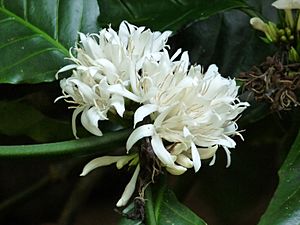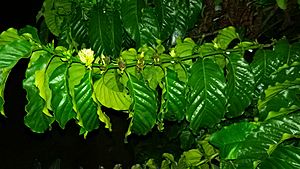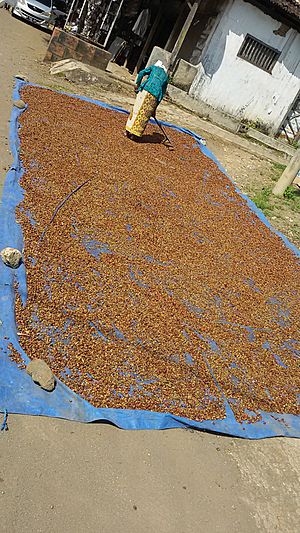Robusta coffee facts for kids
Quick facts for kids Robusta coffee |
|
|---|---|
 |
|
| Berries of Coffea canephora | |
| Conservation status | |
| Scientific classification | |
| Genus: |
Coffea
|
| Species: |
canephora
|
| Synonyms | |
|
Coffea robusta L.Linden |
|
Coffea canephora, often called robusta coffee, is a type of coffee plant. It originally comes from central and western Africa. This plant is a species of flowering plant in the Rubiaceae family. While many people know it as Coffea robusta, its scientific name is Coffea canephora. It has two main types: robusta and nganda.
Robusta coffee makes up about 43% of all coffee produced worldwide. Most of the rest is Coffea arabica. There are some key differences between coffee beans from C. arabica and C. robusta. Robusta beans usually taste less sour and more bitter. They often have a woody flavor, not as fruity as Arabica beans.
Contents
What is Robusta Coffee?
Robusta is a type of flowering plant. It belongs to the Rubiaceae family. Even though it's widely known as Coffea robusta, its correct scientific name is Coffea canephora. This plant grows as a strong tree or shrub. It can reach about 10 meters (33 feet) tall. Its roots are not very deep.
The plant flowers at different times. It takes about 10 to 11 months for its berries to become ripe. These berries then produce oval-shaped coffee beans.
How Robusta Plants Grow
Robusta plants produce more coffee beans than Arabica plants. They also have more caffeine (about 2.7%) compared to Arabica (about 1.5%). Robusta beans also contain less sugar.
These plants are stronger against pests and diseases. This means they need less herbicide and pesticide than Arabica plants. This makes them easier to grow.
Where Robusta Coffee Comes From
C. canephora grows naturally in Western and Central Africa. You can find it from Liberia all the way to Tanzania and south to Angola. Scientists didn't officially recognize it as a coffee species until 1897. This was over a hundred years after Coffea arabica was discovered.
It is also found growing wild in places like Borneo, French Polynesia, Costa Rica, Nicaragua, Jamaica, and the Lesser Antilles. In 1927, a mix between Robusta and Arabica was found in Timor. This special plant was then used to create coffee plants that could resist a disease called rust.
Growing and Using Robusta Coffee
Coffee made from Coffea canephora beans has a low sourness and a high bitterness. It often has a distinct woody and nutty taste. These beans, known as Coffea robusta, are mostly used in instant coffee and espresso. They are also used as a filler in mixed ground coffee.
Robusta coffee is easy to take care of. It produces a lot of beans and has almost double the caffeine of Arabica coffee. It also has more antioxidants. Plus, it's less likely to get sick than Arabica coffee. Robusta makes up 43% of the world's coffee production.
Top Robusta Coffee Producers
Most Robusta coffee is grown in Vietnam. French settlers brought it there in the late 1800s. It is also grown in India, Africa, and Brazil. In Brazil, it's often called conilon.
Vietnam has become the biggest exporter of Robusta coffee. It produces over 40% of the total world supply. This is more than Brazil (25%), Indonesia (13%), India (5%), and Uganda (5%). Brazil is still the largest coffee producer overall. However, 69% of its coffee is C. arabica.
Why Robusta is Popular
Since Robusta is easier to grow and produces more beans than C. arabica, it costs less to make. Roasted Robusta beans create a strong, full-bodied coffee. It has a unique earthy flavor. However, it can be more bitter than Arabica.
Arabica beans are thought to have a smoother, richer taste with more sourness. Because of this, they are often seen as better. The stronger Robusta beans are mostly used in cheaper coffee mixes. But its powerful flavor can be good in a mix. It gives coffee a feeling of "strength" and a good "finish." This is especially true in Italian coffee.
Good quality Robusta beans are used in traditional Italian espresso mixes. They make up about 10–15% of the blend. This helps create a full-bodied taste and a better foam on top, called crema. Robusta is also used as a stimulant, to help with urination, as an antioxidant, to reduce fever, and to help with asthma.
See also
In Spanish: Coffea canephora para niños







